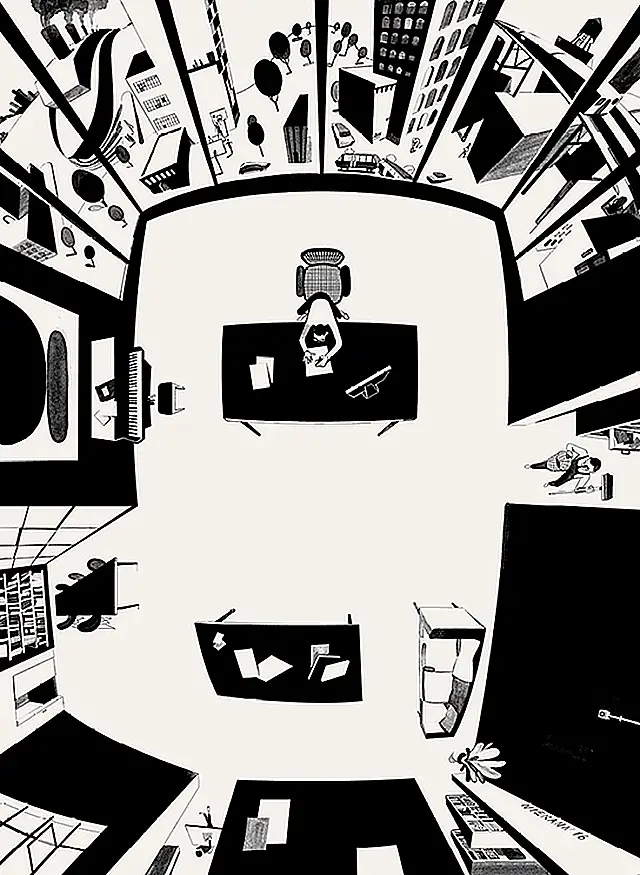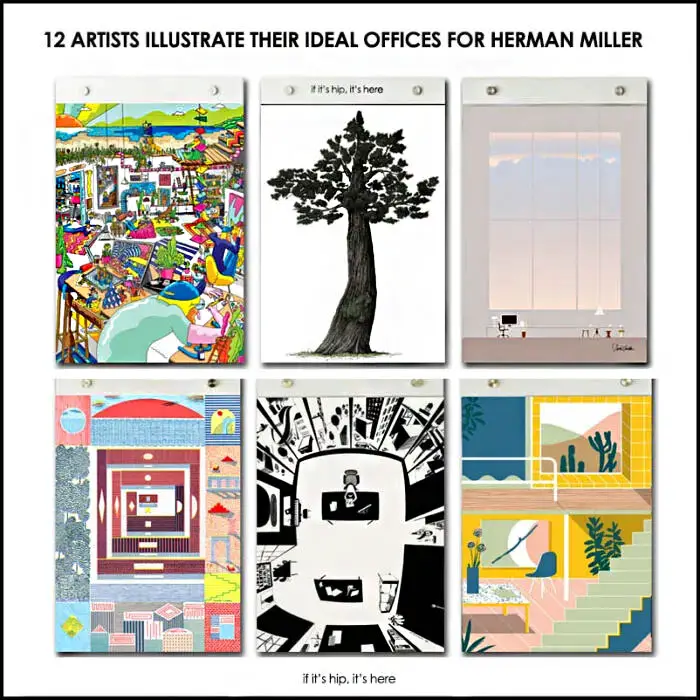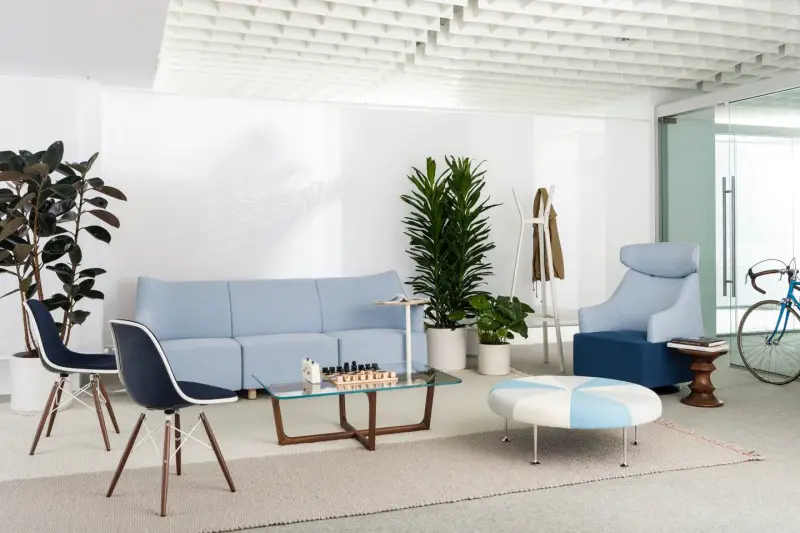As part of their trade display at NeoCon 2016, home and office furniture brand and legendary mid-century modern favorite, Herman Miller, asked 8 artists to envision the ideal workspace and another 4 to envision their ideal places of care in their “What Kind of Place Are You?” project.
Herman Miller What Kind Of Place Are You?

Herman Miller’s own philosophy suggests that workplaces should be thoughtfully designed to embody the purpose, character, and activities of the people who inhabit them. Knowing this means various environments, styles and products for various needs, they enlisted 12 different talents to illustrate this in their own style.
The final Herman Miller What Kind Of Place Are You? artworks are displayed along with Herman Miller’s own beautiful room displays for the home and office at Chicago’s Merchandise Mart.
The Ideal Place to Work.
Would it be more open or closed? More formal or casual? What material choices would make them happy? How much technology would they want? Would the space feel isolated and calm, or crowded and buzzing? Would it be neat or messy?
Daniel Carlsten, Workplace, Stockholm, Sweden:

I have had this idea of an office with just a very long table, loosely divided into different areas for different purposes. The idea being that one could do all things (sketching, drawing, researching, corresponding, evaluating, proofing, and hosting meetings) around the same simple workstation, without having to clear the table between each activity.
It makes no sense for me to have a conference room, as I have few meetings, and my meetings are usually pretty casual anyhow. I don’t like giving presentations, because I feel they always have an element of surprise to them that makes it hard for people to fully relax and be open. I am more productive and at ease in a meeting where we just sit and talk and look at things together as a team, where we can spread things out on a big surface, jump from one subject to another, and add to each other’s ideas.
Regarding the huge window, I like a good view but don’t want too much distraction. A view of the sky, with all its different colors throughout the day, just seems perfect to me.
Emi Ueoka, In Thought, Melbourne, Australia:

The thought of my ideal workplace. A clean space with a nice view and fresh flowers. Somewhere I can think, read a book, or enjoy a cup of tea. The Eames Chaise is a cherry on top.
Mike Perry, This is Going to be a Fun Drawing to Make, New York City, US:

This was the best project ever. The actual assignment was exciting. I just got so pumped. I’m obviously inspired by my own studio space, but I enjoyed dreaming big. It is fun to get surreal and fantasize about what it could be. Part of the journey is about being outdoors, sitting in front of the ocean and watching the sunset. Enjoying life and being inspired by what is around you is so important.
Christoph Niemann, My Perfect Studio, Berlin, Germany:

My perfect studio would have a lot of features. Some realistic, some less so. Among the more feasible are: great light, a sofa (naps!), inspiring friends next door, and an unnecessarily large space (bordering on the vulgar). Less realistic, but splendid, would be views of a city, ocean liners, railways, and a basketball court. An assistant that lingers in a side room constantly cleaning up (I’m messy, but like a clean environment). Direct access to an art supply store as well as wireless distribution of electricity (yet to be invented) are optional.
Hannah Waldron, Inner Space , London, U.K.:

The studio for me is both a place to retreat to, but also a place to process the world from. It is a time and space both physical and mental to go deeper into ideas. I love the structure of a spiral because it allows seclusion without being enclosed, and this structure I have imagined would allow glimpses out, and in. Glimpses as thoughts, observations, memories, or interactions. In my ideal studio I would have all my favorite surroundings at once: the sea, the city, the forest, and the trace of something past. “My ideal studio I would have all my favorite surroundings at once: the sea, the city, the forest, and the trace of something past.”
Thibaud Herem, Tree London, U.K.:

I want to be in a more natural environment, not that I want to live in the countryside, but more like a consideration of the nature within the city, and be more eco-friendly for sure. I like the idea of using recycling paper to draw a tree too.
Elena Boils, Dream Studio, London, U.K.:

This image came together by grouping certain details that I found interesting. For example, I really wanted this image to have a window which had an amazing view. I was inspired by the current studio I work in, since the view is very much its defining feature. The other architectural and decorative elements I found everywhere and anywhere. I like to go through old interior design archives and pick elements that I think would work well in an image. I saw a mezzanine living room which I thought was exactly the kind of thing I would love to have in a workspace. I drew my initial idea from that and the rest followed. Balance was really important and with this image I was hoping to achieve this not only in the composition but also in the colors. I chose colors that contrast yet complement each other, to make the image not only interesting in content but also in aesthetic.
Nathaniel Russell, House Plant House, Indianapolis, U.S.:

My inspiration was a desire for solitude and a peaceful setting without being too far from home or the people I love. If I could somehow shrink in size and find a place to work, invisible from outside distractions that may come calling, it could be a kind of house-mouse-studio situation. “My inspiration was a desire for solitude and a peaceful setting without being too far from home or the people I love.”
Individualized Places of Care
Herman Miller’s point of view on healthcare environments is a natural extension of our point of view on the workplace. The places where people give and receive care should be as humane as the people who work in them, unique as the people who heal in them, and supportive as the people who visit their loved ones in them. With this in mind, they asked four artists to envision their ideal places of care. These images serve as a reminder that the best design is both intimately personal and inherently universal.
Hanna Konola, Pastel Forest, Helsinki, Finland:

Color is a very important language to me and I was inspired by the use of color by Herman Miller and the emphasis that has been put to that. Also, as I very often am, I was curious about what I can express with quite simple, geometric shapes and creating a certain feeling with them.
I aimed to create a soft and kind atmosphere full of playful shapes and colors. I hoped it to be a place where you can imagine yourself being in nature and feel the energy of it, a place that fuels your imagination and playfulness, yet has a feeling of serenity. For me it was important to have a subtle sense of movement in the picture, a flowing, calm kind.
Mark Warren Jacques, A Simple & Open Place, Columbus, OH, U.S.:

A simple space that is easy to understand. A place of connectedness to body and mind.
Mike Ellis, Inside/Out , Toronto, Canada:

As a child I spent a lot of time in and out of hospitals. Once a month my parents and I would drive to Sick Kids Hospital in Toronto for appointments. I know the feeling of vulnerability that often situates itself in the sterile settings of a hospital waiting room. At an early age I learned the benefits of escapism, withdrawing into one’s own mind for entertainment and enjoyment. I would often find myself imagining wonderful open landscapes with the sounds of water on a beach and mountains in the distance.
From an early age I found solace in nature, thus natural elements are what inspired my final poster design. The sights, sounds, and warmth found in my ideal natural setting. I believe that a good place of care is one that blurs the boundaries between function and comfort. A space that helps you forget why exactly you are there and acts as a vessel aiding in the healing process.
Jing Wei, Waiting Room New York City, U.S.:

For this piece, I wanted to create small, private moments within a public landscape. I liked the thought of multiple stories existing in a single open space, so I started with an empty room, and slowly built furniture and characters to occupy it. Even though this is a healthcare environment, the space itself is inspired by a combination of a gallery and a video game, complete with impractical staircases and a ladder that leads to nowhere.

The posters will be on display June 13–15, 2016, in the Herman Miller showroom at the Chicago Merchandise Mart.
With Living Office, Herman Miller proposes that if people are different, and the work they do is different, then the places where those people work should be different too. And not just different for difference sake. Workplaces should be thoughtfully designed to embody the purpose, character, and activities of the people who inhabit them. Using this unique approach, organizations can create workplaces that fulfill distinct needs and create distinct meaning.
A few of their beautiful room and workspace settings at NeoCon 2016:
Herman Miller at NeoCon 2016
all images and information courtesy of Herman Miller and/or their blog






